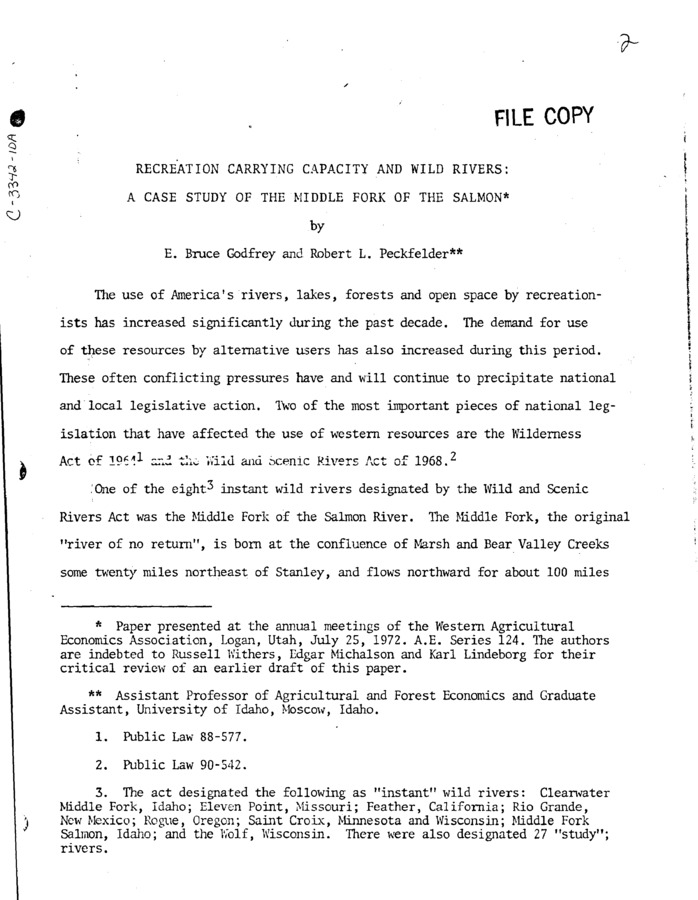PDF
Recreation carrying capacity and Wild Rivers: a case study of the Middle Fork of the Salmon Item Info
- Title:
- Recreation carrying capacity and Wild Rivers: a case study of the Middle Fork of the Salmon
- Authors:
- Godfrey, E. Bruce; Peckfelder, Robert L.
- Contributors:
- Idaho Water Resources Research Institute; IWRRI
- Date:
- 1972-07-25
- Description:
- One of the eight instant wild rivers designated by the Wild and Scenic Rivers Act was the Middle Fork of the Salmon River. The Middle Fork, the original ''river of no return'', is born at the confluence of Marsh and Bear Valley Creeks: some twenty miles northeast of Stanley, and flows northward for about 100 miles through one of America's deepest gorges to join the min stem of the Salmon Below Shoup. It is a fast-flowing stream with numerous rapids and falls. Stretches of relative calm, however, can ''ease one to sleep'' before the next series of rapids greets the-unsuspecting floater. The lower 80 miles of the river is part of the Idaho Primitive Area. The fast-flowing, relatively pure and primitive characteristics of the river has nude it a national attraction for recreationists . River runners, hunters, fishermen, sightseers, and backpackers commonly confront the rugged confines of the area during the short summer season when snow packs allow access. Until the mid 1940's, only a limited number of hunters, prospectors, trappers, and fishermen used the area. In 1959, the Forest Service constructed a road to the upper reaches of the river that opened the area up and allowed a substantial increase in recreational use. For example, between 1962 and 1971 the number of Middle Fork floaters increased more than five times. The large increase in recreational use on the Middle Fork has helped generate considerable concern on the part of the Forest Service regarding the impact of this use on the environment of the area. Should use be limited? If so, when, how, and why? In an effort to provide some insight into these matters a study was initiated in 1970 to determine the recreational carrying capacity of the Middle Fork. This paper presents some of the preliminary results of that study.
- Subjects:
- recreation wastes water pollution control
- Location:
- Salmon River Basin
- Idaho County:
- Idaho County
- Latitude:
- 45.77
- Longitude:
- -115.08
- Source:
- Idaho Water Resources Research Institute, University of Idaho
- Identifier:
- IWRRI Number 197207
- Publisher:
- Idaho Water Resources Research Institute, University of Idaho
- Contributing Institution:
- University of Idaho
- Type:
- Text
- Format:
- application/pdf
- Cataloger:
- wbv
- Date Digitized:
- 2012
- Language:
- eng
Source
- Preferred Citation:
- "Recreation carrying capacity and Wild Rivers: a case study of the Middle Fork of the Salmon", Idaho Waters Digital Library, University of Idaho Library Digital Collections, https://www.lib.uidaho.edu/digital/iwdl/items/iwdl-197207.html
Rights
- Rights:
- In copyright, educational use permitted. Educational use includes non-commercial reproduction of text and images in materials for teaching and research purposes. For other contexts beyond fair use, including digital reproduction, please contact the University of Idaho Library Special Collections and Archives Department at libspec@uidaho.edu. The University of Idaho Library is not liable for any violations of the law by users.
- Standardized Rights:
- http://rightsstatements.org/vocab/InC-EDU/1.0/

